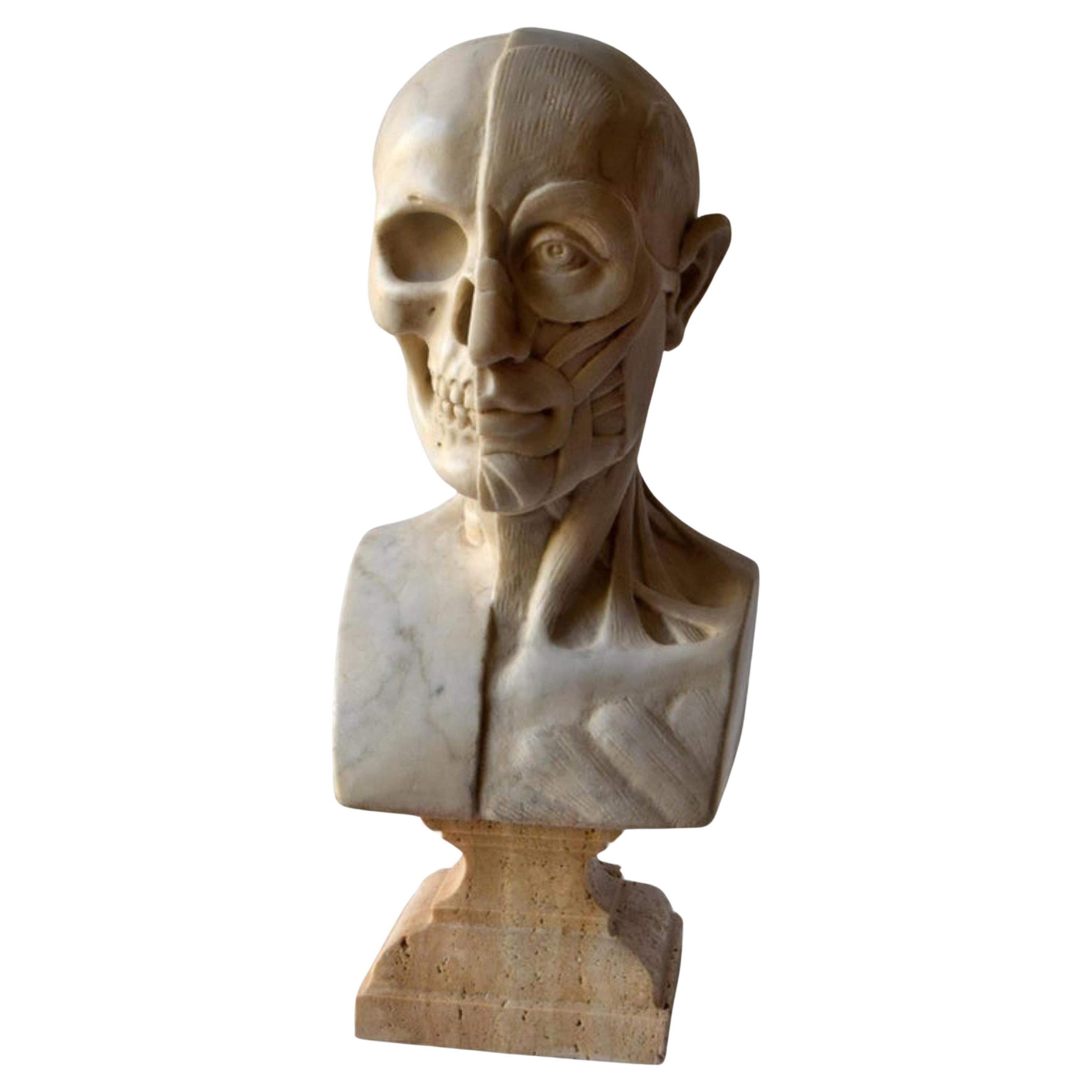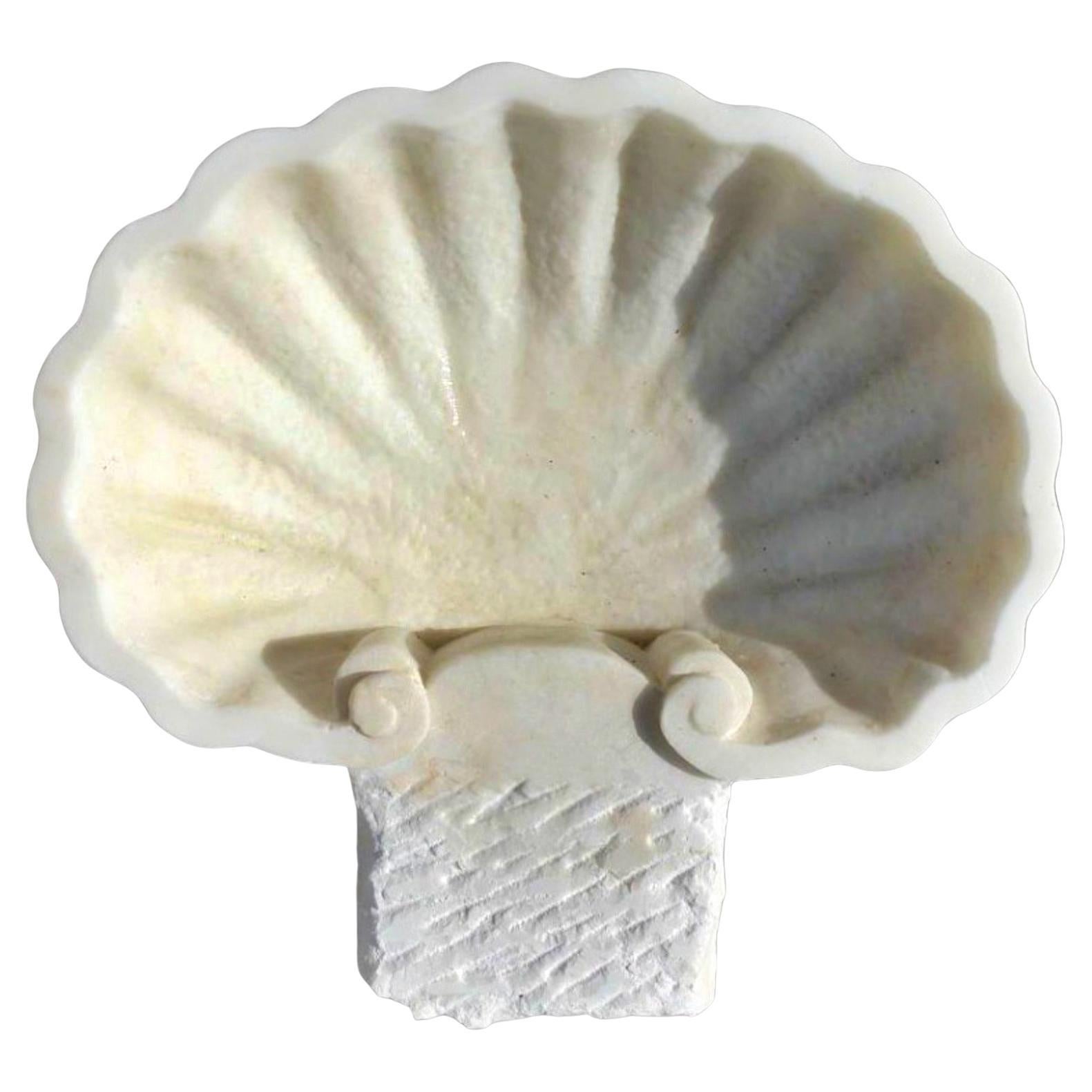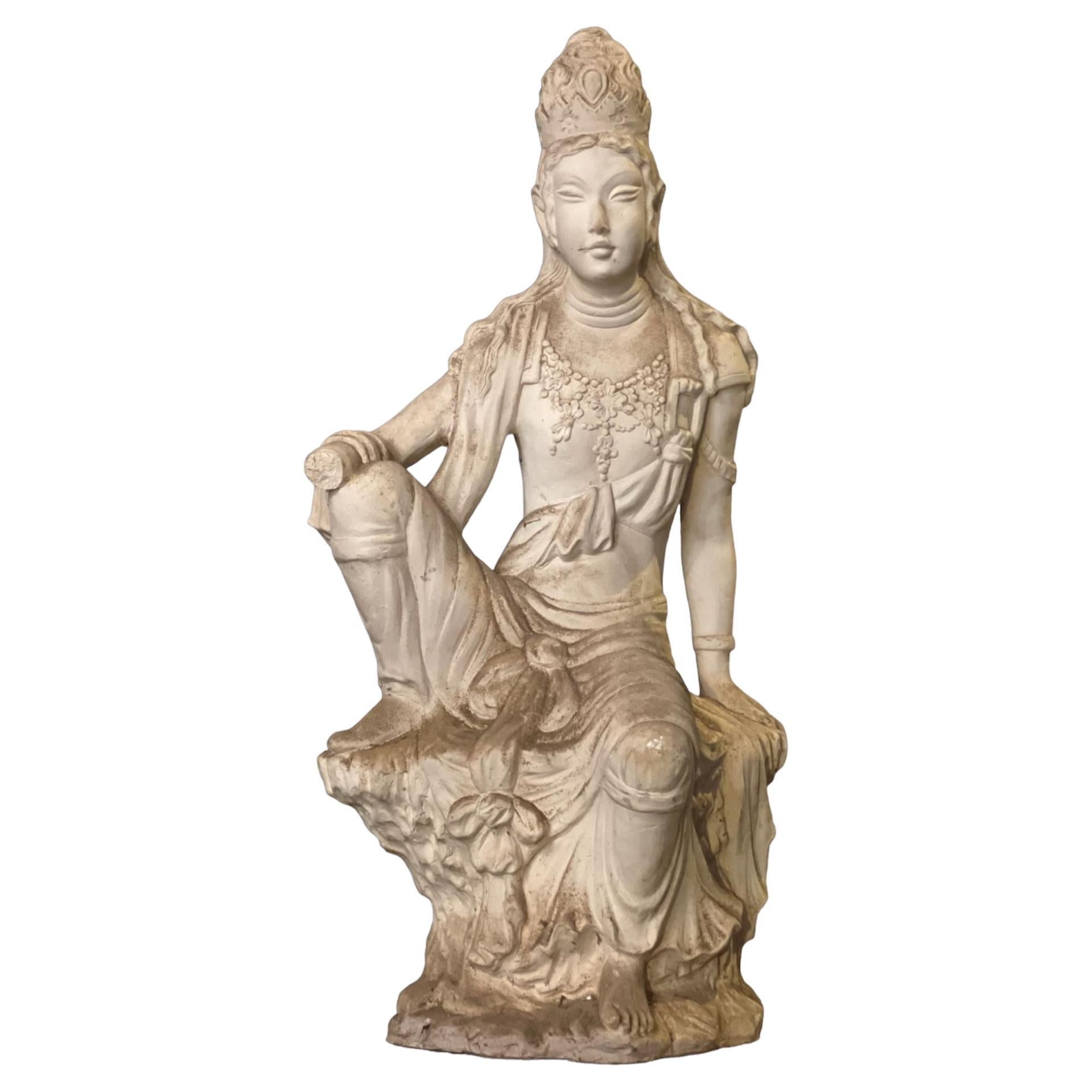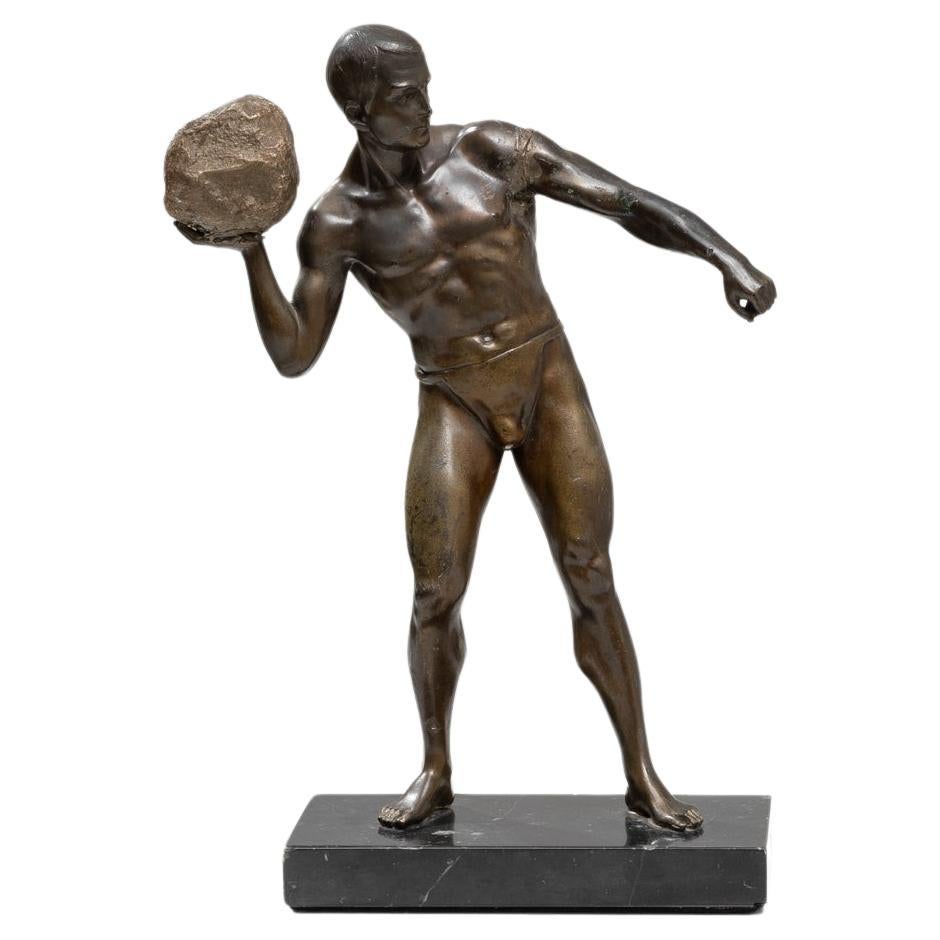Items Similar to Early 20th Century Gallant Scene with Citadel White and Green Marble Sculpture
Want more images or videos?
Request additional images or videos from the seller
1 of 18
Early 20th Century Gallant Scene with Citadel White and Green Marble Sculpture
About the Item
Early 20th century
Gallant scene with citadel
White marble and green marble from the Alps, cm 59 x 48 x 29
Signed on the back "G. Abell"
The refined marble group describes the episode in which a citadel happily intones a singing step, accompanied by the lyre. The ecstatic expression of the young woman sitting before him, equipped with an elegant fan, contrasts with the melancholy face carved on the elaborate seat occupied by the couple, in which Medusa is recognizable, not at all by chance.
Gorgon sister of Stenus and Eurialis, originally inhabitant at the edge of the night, Medusa was a monstrous being with its head covered with snakes. The power to petrify whoever had met her gaze, conferred on her by the prodigious crown, did not cease even when the hero Perseus took off, making a gift of the head to Athena, who affixed it to his shield. To the displeasure of his departure, the sisters Steno and Euriale sang a lament so tragic that Athena memorized the notes to compose a melody to give to men. From this melody was born the music, used in the present marble by the citadel to enchant the young woman.
If the relief with the head of Medusa, loaded with the moving expressiveness typical of late Hellenism, is the figurative outcome of the contamination between the sculptural representations of the Roman oracles, the iconography of the same Medusa and the masks of the ancient Greek and Roman theaters, the cheerful plasticism of the singer and the woman is affected instead by the full modern climate to which the whole group is attributable. The signature on the back of the marble, "G. Abell", reveals in fact that the marble is the work of this French sculptor, active above all between the twenties and thirties of the last century, expert in the processing of bronze and chryselephantine sculptures, as evidenced by some examples appeared on the market.
- Dimensions:Height: 23.23 in (59 cm)Width: 18.9 in (48 cm)Depth: 11.42 in (29 cm)
- Materials and Techniques:
- Place of Origin:
- Period:
- Date of Manufacture:Early 20th Century
- Condition:Wear consistent with age and use.
- Seller Location:Milan, IT
- Reference Number:1stDibs: LU5918233565512

About the Seller
5.0
Vetted Seller
These experienced sellers undergo a comprehensive evaluation by our team of in-house experts.
Established in 2000
1stDibs seller since 2021
25 sales on 1stDibs
Typical response time: 12 hours
- ShippingRetrieving quote...Ships From: Milan, Italy
- Return PolicyA return for this item may be initiated within 14 days of delivery.
More From This SellerView All
- 20th Century Reclining Woman with Sphinx Sculpture AlabasterLocated in Milan, IT20th Century Reclining woman with Sphinx Alabaster, 43 x 60 x 25 cm The sculpture depicts a young and charming odalisque lying languidly on a refined sheet. The face with d...Category
20th Century Italian Figurative Sculptures
MaterialsAlabaster
- Sculpture depicting Dante and Beatrice, Alabaster, 20th centuryLocated in Milan, ITDante and Beatrice Alabaster, 33 x 20 x 36 cm Early 20th century The present alabaster relief, of which great technical skill is evident, imitates the pages of a book, On the two...Category
20th Century Figurative Sculptures
MaterialsAlabaster
- 20th Century Child with Hat Sculpture Bronze by Tommaso CampajolaBy Thomas CampajolaLocated in Milan, ITTommaso Campajola (Active in Naples between the 19th and 20th centuries) Child with hat Bronze, height 23 cm Signed and dated 1932 on the back.Category
20th Century Figurative Sculptures
MaterialsBronze
- 18th Century Immaculate Conception with Saints Sculpture MarbleLocated in Milan, IT18th century Immaculate Conception and saints Marble, 60 x 50 x 9 cm In the center of the marble oval we find an Immaculate Conception accompanied by St. Vincent Ferrer (identifiable thanks to the presence of the wings and the Dominican dress), and by two saints of difficult identification, one of them with a monastic habit. The theme of the Immaculate Conception began to appear in artistic works ever since the debate began, which saw the Franciscans and the ramifications of the Benedictine Order lined up on one side, linked to the thought of Anselmo d'Aosta and Bonaventura da Bagnoregio, and on the other the Dominicans, linked to the discussion offered by Thomas Aquinas...Category
Antique 18th Century Italian Figurative Sculptures
MaterialsMarble
- Lion Marble sculpture from the 17th centuryLocated in Milan, ITXVII Century Lion Marble, 30 x 43 x 25 The object under consideration is configured as a marble sculpture referable to the 17th century, characterized by a strong, visceral langua...Category
Antique 17th Century Italian Animal Sculptures
MaterialsMarble
- 17th Century Rural Landscape with Gallant Scenes Painting Oil on CanvasLocated in Milan, IT17th century, Emilian school Rural landscape with gallant scenes Oil on canvas, 37 x 47.5 cm With frame 61 x 50.5 cm The bucolic amenity of the present is reflected in the joyful gallant scenes that dot its surface. The locus amoenus described reflects on the more traditional inflection of Arcadia, which in the literary transfiguration was the scenario par excellence of the most carefree pastoral life and out of this world; the painting is therefore a forerunner of what was professed by the actual poetic academy of Arcadia which was established in Rome in 1690, but enthusiastically testifies to the feverish invitations to its acceptance, then widespread in the most avant-garde cultural salons throughout Italy. First Theocritus and Virgil later had awakened with Idilli and Bucoliche that capacity typical of the natural world to allow an escape from reality; the contemplation of perfect natural fruits that followed would have evoked in the spirits of dreaming men back to origins. The bucolic landscape was able to positively give a rhythm to material life, and constituted the concretization of a place devoid of incivility and ugliness, where only dreams, wild music and homages to fruitful nature were allowed. In the present painting widespread figures of shepherd children trace the same intent to the sublimation of earthly life, gathered in pairs, while children on the model of the ancient cherubs cheer the field with flowers and petals. The games of these and the sweet affections of the other characters are rendered through liquid and vibrant brushstrokes, flickering with a white light that opposes the dark shadow of the undergrowth. In the distance, the sky tapers with a silvery and flat brushstroke, while the vertical development of the promoters with architectures helps to introject a bright beam of light into the grassy clearing. The foliage and the turf of the landscape piece are rendered through a digital brushstroke, betraying the Italian brand of the present, influenced at the same time by the seventeenth-century European influences that then conveyed to the capital. The evocative culture of the city attracted many artists from the city of Bologna, from the Italian north but also from the territories beyond the Alps, such as Claude Lorrain and Nicolas Poussin. The historical-artistic heritage of the Italian pastoral scenes was thus able to fill up with the more functional and particular formalisms of the charms coming from elsewhere, such as the expressive tremor of the present, similar to the contemporary French lexicon. The typological restitution from pastoral idyll, in accordance with the intrinsic stylistic qualities of the work, allows us to specify the solid belonging of the present to the Italian hand, similarly to what was then emerging in the pictorial sphere within the Emilian school. In this regard, we should recall the latent influences of two decisive foreign landscape painters who passed through the Emilian belt, such as Claude Lorrain (1600-1682) and Nicolas Poussin (1594-1665); before them, Giovanni Battista Viola...Category
Antique 17th Century Italian Paintings
MaterialsCanvas
You May Also Like
- Anatomical Sculpture in White Carrara Marble, Early 20th CenturyBy Europa AntiquesLocated in Madrid, ESAnatomical Sculpture in White Carrara Marble early 20th century. Sculpture in white Carrara marble representing a human bust whose half is skeleton, the other half is flayed. Placed ...Category
Early 20th Century Italian Baroque Busts
MaterialsCarrara Marble
- 20th Century Marble SculptureLocated in Guaynabo, PRThis is a 20th century Marble Sculpture. It depicts a black marble abstract sculpture supported by a rectangular wood base. It was made by a Puerto Rican sculptor named G.Nunez.Category
20th Century American Modern Abstract Sculptures
MaterialsMarble
- Early 20th Century Italian White Marble StoupBy Europa AntiquesLocated in Madrid, ESEarly 20th Century WHITE MARBLE STOUP Italy amazing condition hand made HEIGHT 15cm WIDTH 52cm DEPTH 50cm.Category
Early 20th Century Italian Baroque Figurative Sculptures
MaterialsCarrara Marble, Marble
- Early 20th Century Beautiful white terracotta sculptureLocated in Firenze, ITBeautiful white terracotta sculpture depicting an oriental goddess. Extremely refined drapery, garments and headgear, Tuscany, early 20th century. - The hand of the sculpture needs ...Category
Early 20th Century Italian Figurative Sculptures
MaterialsTerracotta
- Early 20th Century Bronze SculptureLocated in High Point, NCShowcase a piece of dynamic artistry in your space with this early 20th-century bronze sculpture. This striking figure captures a moment of intense action, depicting a muscular male ...Category
Early 20th Century French Figurative Sculptures
MaterialsBronze
- 20th Century Abstract Marble SculptureLocated in Denton, TXAbstract sculpture carved with three different faces is perfect for a center table location or garden.Category
20th Century Mid-Century Modern Statues
MaterialsMarble





